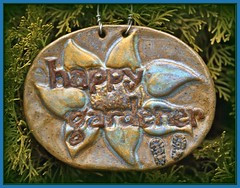 |
| finished garden tile |
I have completed two of the garden tiles requested for the Happy Gardener Tour (only 40 to go)! All the steps necessary are turning this into quite the adventure for me. For anyone interested in this process, I'm going to give a play-by-play of the work involved.
First off, there was the design to consider. I picked up a pencil and paper and worked out some options. Many drawings later and a go ahead from the nurseries, this idea was shaped in clay. A few adjustments and three tiles later, I was finally happy with the results and ready to tackle the next step.
 |
| the sketch idea that won out |
A carefully measured mixture of plaster and water was blended and poured onto the tile. Keeping my fingers crossed, I gave it time to set firm. I removed the framework from the mold and encouraged the master tile out. And because of the scale of this project, I poured another mold. Now I would be able to work two at a time. (For pictures and details of this affair, scroll down to the entry entitled
Plaster Molds.)
 |
| clay pressed into molds |
I rolled out clay and pressed it into the molds, smoothing it flat with a rubber scraper. At this point I also stamped the backs with my studio logo and name. I gave them several hours, checking for shrinkage, which would allow them to more easily be removed. Once the clay began to pull away around the edges, I gently urged them out of the molds and left them to dry.
 |
| different stages of drying |
At this point the tiles were ready to be fired, which makes them easier to handle when glazing. This was the beginning of becoming a mini-factory, pressing more clay into the molds. This is where I will be for a while. As each pair of tiles finishes its job at one station, I move it onto the next.
I've learned it's best to test out my coloring scheme ideas before diving into it and simply hoping for a good result. I mocked up a few sample tiles, fired up the kiln a second time, and returned the following day to see the verdict. I was happy to see how the twilight blue combined with the french mustard. It was time for the final plunge.
 |
| just glazed and ready for the kiln |
I painted the first set of tiles with my favorite blend of glazes. Months of thought and wonder about their final stage would reveal itself in 24 hours. And there they were. Two tiles shining back at me from within the kiln walls.
I couldn't wait to get them outside in the light. The sun brought out the iridescence in the blue and highlighted the texture. I rummaged up some steel wire, twisted it through the hanging holes and hung it up to evaluate. Voila! A tile now ready for the spring garden tour in the beautiful St. Croix Valley. And so the journey continues, one step at a time.

 I had just been married. Over 350 friends and family came to celebrate that day, filling my parents' backyard with color and life. One of the guests was my cousin from Bayfield who I had only met once as young girl. He asked me to dance and then, with no hesitation invited us to stay with him. So it was from a pop-up camper set in the middle of his apple orchard that I would bike off to the pottery each day.
I had just been married. Over 350 friends and family came to celebrate that day, filling my parents' backyard with color and life. One of the guests was my cousin from Bayfield who I had only met once as young girl. He asked me to dance and then, with no hesitation invited us to stay with him. So it was from a pop-up camper set in the middle of his apple orchard that I would bike off to the pottery each day.
















































